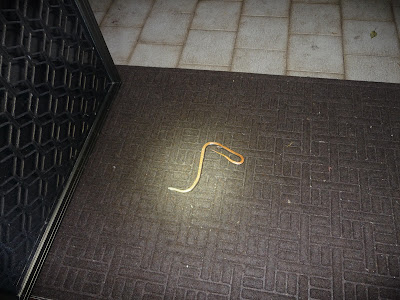We'd just had a week of pouring rain and the only nature study we'd done for a while was on our cat, watching him jumping at shadows and pulling on the ironed shirts I'd just hung up. Then at the beginning of the next week our daughter rang (from the driveway) and said, "Dad, I think there's a snake at the front door. Could you come and have a look?” It was only a very young (dead) snake. Being the first week of winter we were surprised to see a snake, especially when we'd had such cool weather.
This beautiful male king parrot (Alisterus scapularis) came and sat in the tree outside our kitchen window. We have a bird bath nearby and lots of small to medium bushes and trees which attract the birds and give them a refuge if they're disturbed. This is one of our favourite birds, so gentle and beautifully coloured. The female was nearby, less showy with mostly green plumage.
A very useful website for identifying Australian birds: http://www.birdsinbackyards.net/finder Photographic Field Guide Birds of Australia by Jim Flegg is a book we refer to regularly also.
We'd kept our chickens cooped up during the deluge so they made the most of their liberty and probably got some good pickings with the rain forcing the earthworms to the surface.
We had a nature walk this week on our suburban block which backs onto a bush reserve. Our chooks started digging up the garden and eating my pot plants so we moved them on and then decided we might as well get some kindling while the sun was out which led to the discovery of some interesting mushrooms………
Autumn and early winter is the best time to observe fungi in Australia.
We had a bit of a hunt to find this Bracket Fungi.
And if you really want to get serious try the Australian Fungi Website which is part of the Australian National Botanic Gardens.
And then we had a look at some mosses and lichen.
Did you know?
That lichens are used as pollution monitors.
They are very sensitive to pollution in the atmosphere so they're not often found in cities or industrial areas.
They are called the 'termites of the plant world.'
They were a source of purple dye in Mediaevel times.
They are not separate organisms but are a partnership between an alga and a fungus.
Litmus dye comes from lichen.
Some lichen have antibiotic attributes.
The grey/white splotches on this sandstone rock are lichens:
The cat decided to join us.
The obligatory leeches. We've got a dedicated packet of salt kept in readiness for getting rid of these as someone is sure to carry some home if we've had rain.
As I'm writing this the rain has started again and the forecast is for rain all week. We'll go back to looking at the cat's antics (indoors) for awhile I think.















